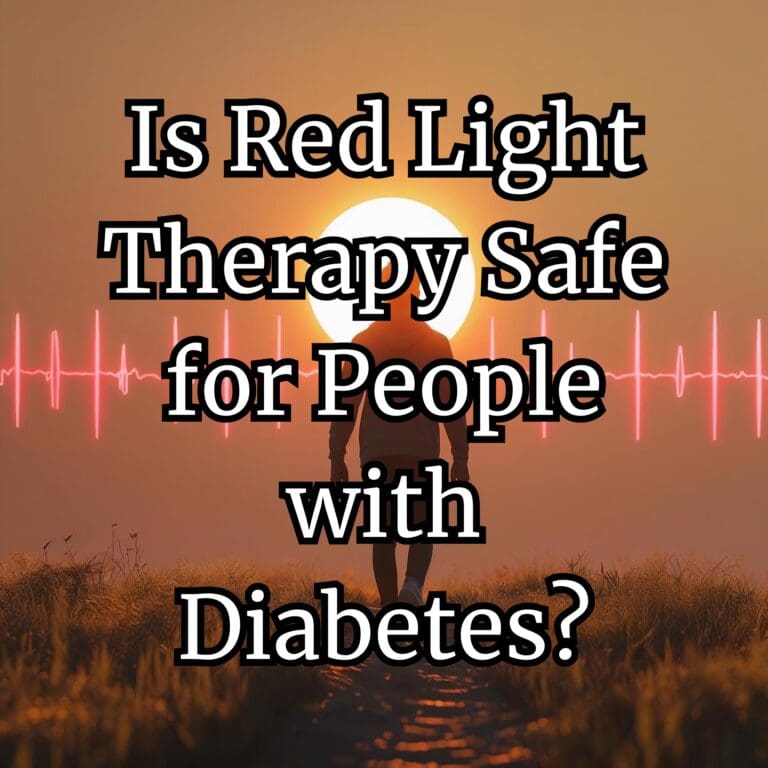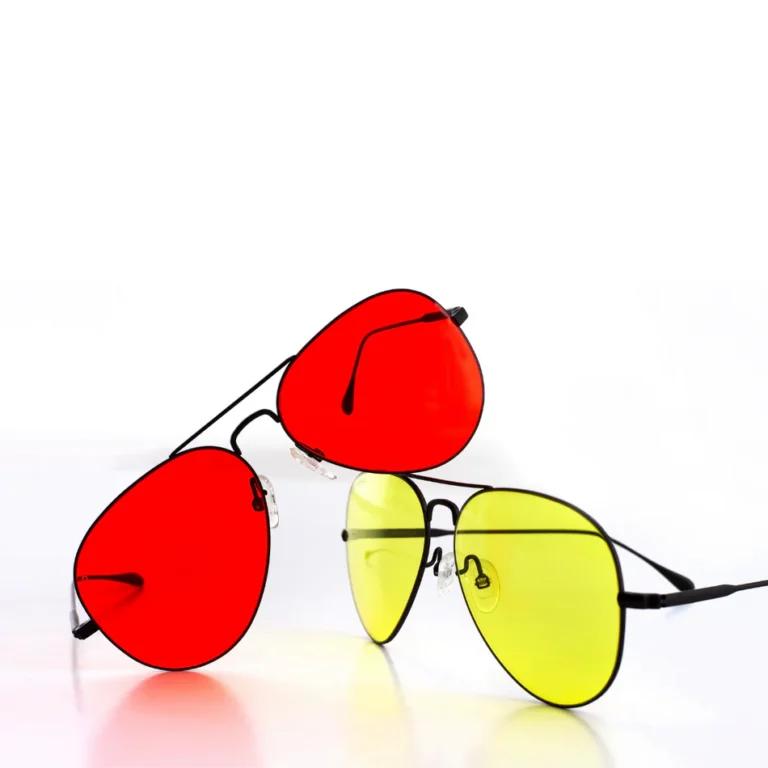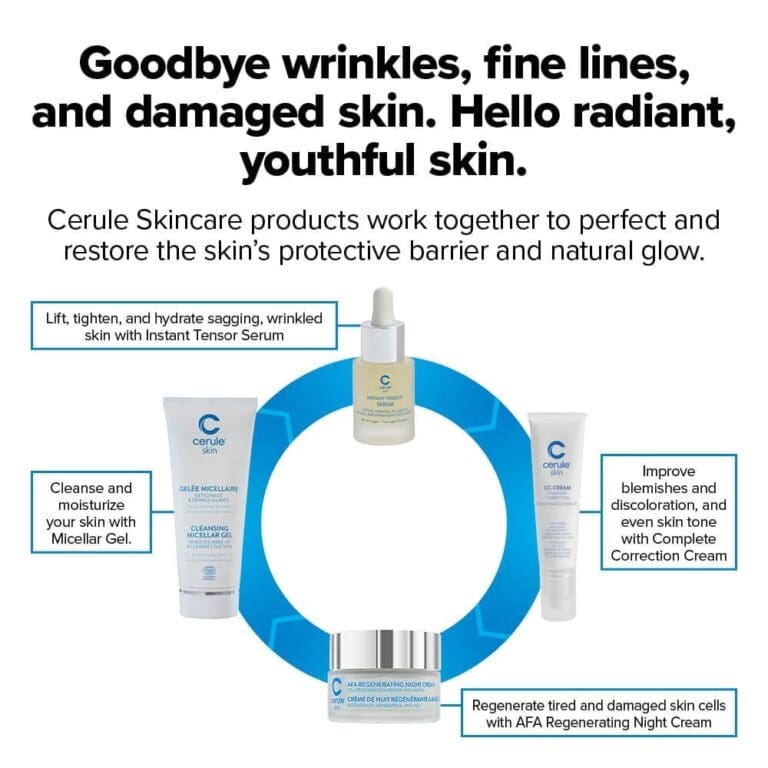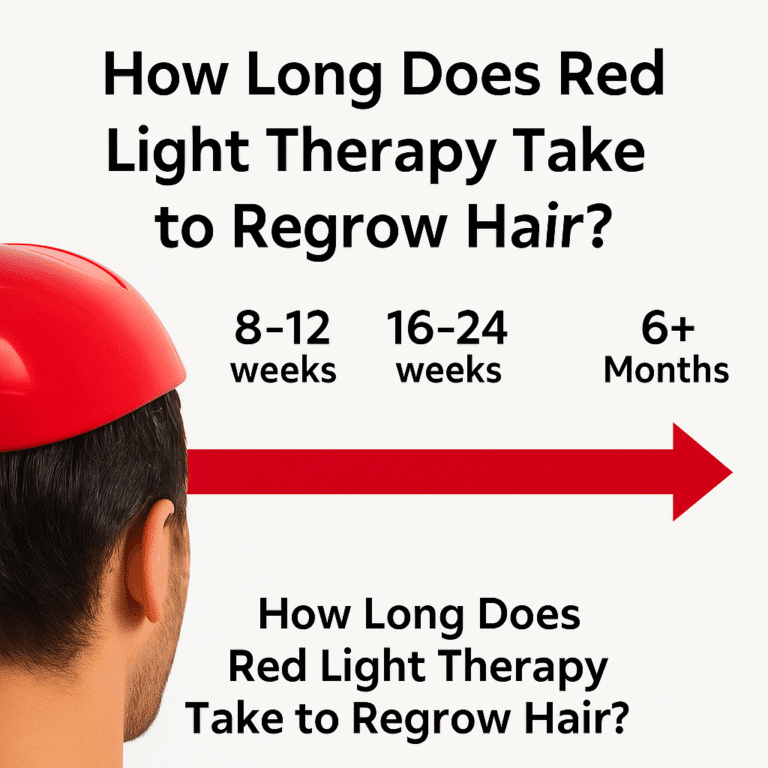Introduction: Rosacea is a chronic skin condition that causes persistent facial redness, visible blood vessels, and often acne-like bumps. Those who suffer from rosacea know how frustrating the flare-ups of flushing and inflammation can be. While traditional treatments (like topical metronidazole, azelaic acid, or laser therapy) help manage symptoms, interest is growing in red light therapy (RLT) as a calming, drug-free addition to the rosacea toolkit. Red light therapy uses low-intensity red or near-infrared light to soothe and rejuvenate the skin.
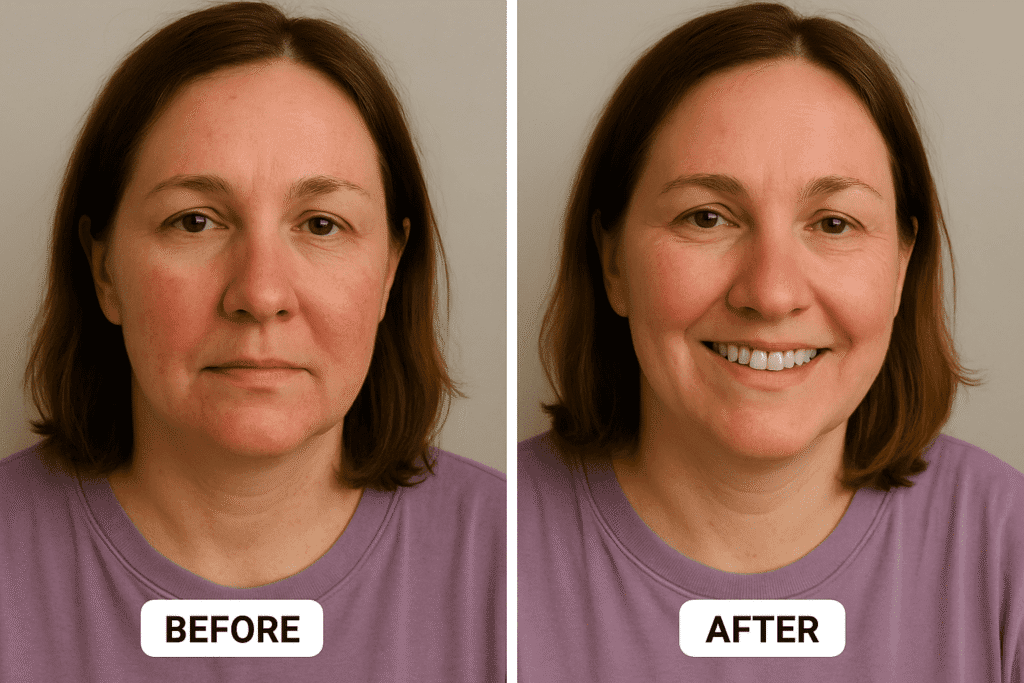
For rosacea patients – who typically have very sensitive skin – the idea of a gentle light-based treatment that can reduce redness and bolster the skin’s resilience is quite appealing. In this comprehensive guide, we will explore how RLT works for rosacea, share scientific findings and dermatologist opinions, and provide practical advice on choosing and using red light therapy for rosacea relief.
Why Consider Red Light Therapy for Rosacea?
Rosacea primarily involves chronic inflammation and vascular reactivity in the facial skin. Blood vessels near the surface dilate easily (causing flushing and persistent redness), and inflammatory substances in the skin lead to papules/pustules and burning sensations. Red light therapy targets these issues in multiple ways:
- Reduces Inflammation: Red light has well-documented anti-inflammatory properties. In rosacea, there is ongoing low-grade inflammation; RLT can help dial that down. By penetrating into the dermis, red light can influence inflammatory cells and cytokines, likely decreasing the release of pro-inflammatory signals. This results in calmer skin over time. Dermatologist Dr. Fricke notes that red light therapy “helps by reducing inflammation and redness” in rosacea-prone skin. Essentially, it provides a soothing effect at the cellular level, mitigating the constant irritated state rosacea skin lives in.
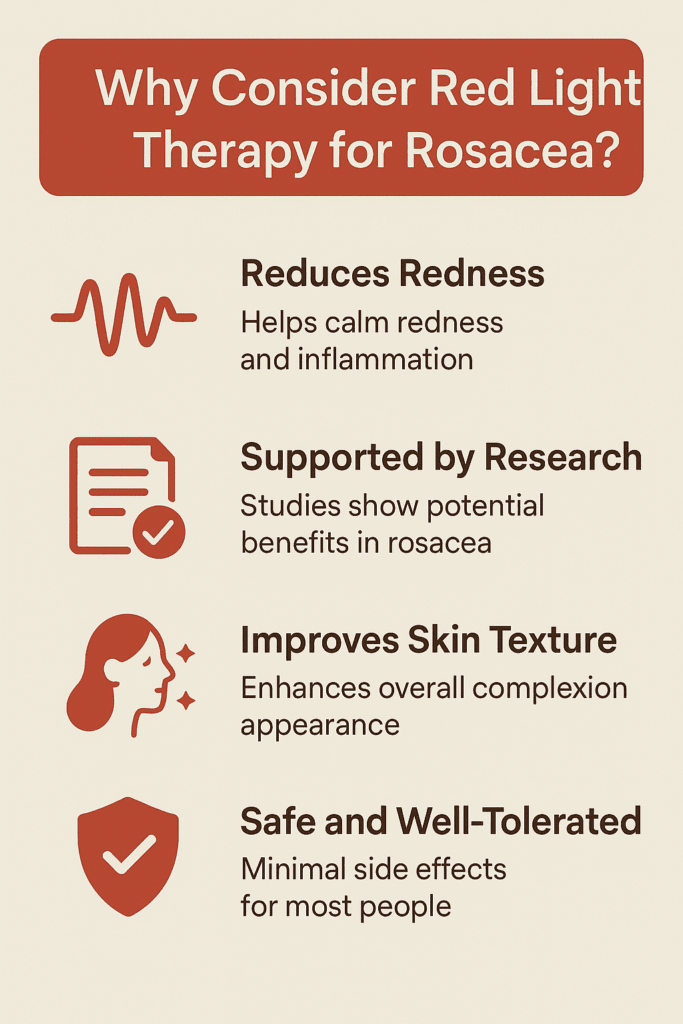
- Calms Redness and Flushing: Red light may also exert effects on the blood vessels. Rosacea redness comes from vessels that are enlarged or swollen with blood. While RLT is not as potent as laser treatments (like IPL or pulsed-dye lasers) at collapsing visible vessels, it can strengthen the skin support structure around vessels. By stimulating collagen production in the dermis, red light might make blood vessels less visible and less prone to extreme dilation over time. Some patients report that after using RLT regularly, their baseline redness is diminished and they experience fewer intense flushes. Combined with its anti-inflammatory effect, this means a more even, less ruddy complexion.
- Supports Skin Barrier and Healing: Rosacea often comes with a compromised skin barrier (leading to sensitivity, stinging with products, etc.) and sometimes with coexisting seborrheic dermatitis or irritation. Red light therapy encourages cellular repair and new tissue growth, which can improve the overall skin barrier function. It also aids wound healing – for instance, if you have any rosacea pustules or irritation, they may resolve faster under RLT. There’s also a psychological benefit: lying under a warm red light can be relaxing, and stress is a known rosacea trigger; the therapy session itself might provide stress relief, indirectly helping rosacea.
One of the key reasons red light therapy is being embraced by some rosacea sufferers is its gentleness. Rosacea skin can react poorly to many things – harsh chemicals, hot water, UV sunlight – but red light (when used properly) does not cause burns or irritation. It is a non-thermal, non-UV light. People often describe it as a comforting glow that actually feels soothing on the face. Considering rosacea patients are often cautioned to avoid saunas, steam rooms, sunbathing, and spicy food (all things that heat or inflame the skin), it’s nice that here is a source of light/heat that instead heals and calms rather than aggravates.
Evidence of Effectiveness and Expert Opinions
The use of light-based therapy for rosacea isn’t entirely new – dermatologists have long used laser and intense pulsed light (IPL) to treat rosacea’s vascular symptoms. Red light therapy, however, uses lower-intensity, broader illumination rather than concentrated laser beams. While large-scale trials are still needed, some small studies and case reports have shown promising outcomes for rosacea with LED therapy:
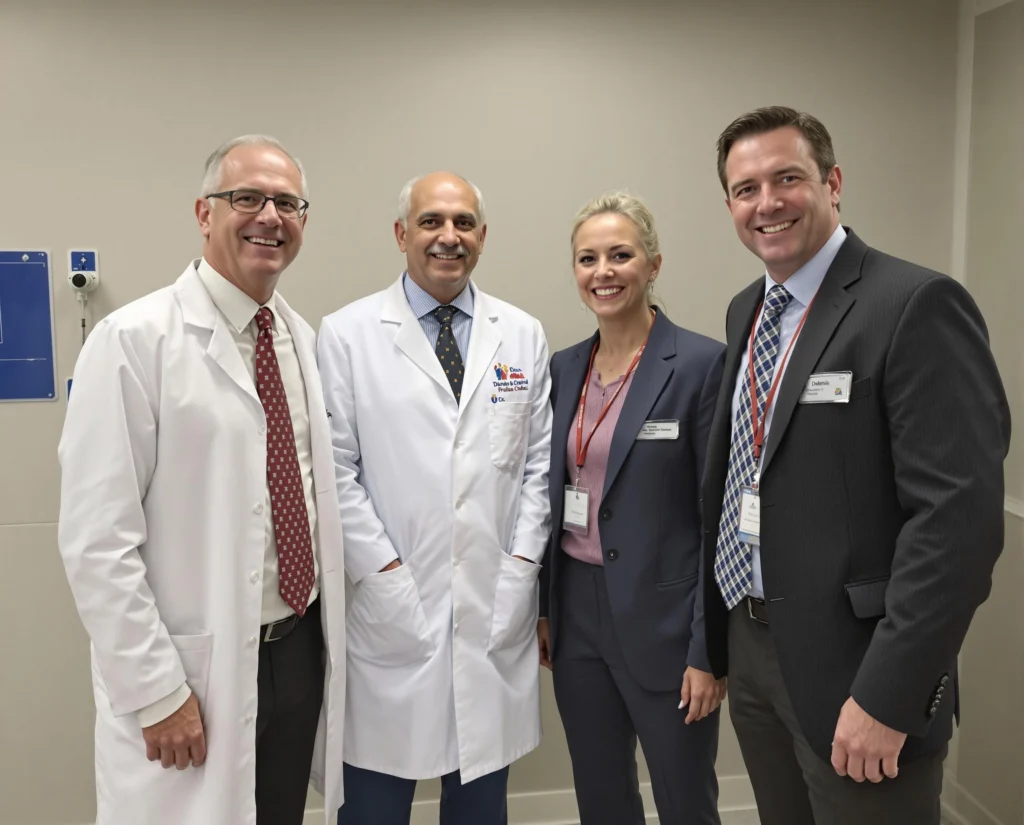
- A 2020 case report by Sorbellini et al. documented two patients with papulopustular rosacea who were treated with a combination of blue (480 nm) and red (650 nm) LED light twice weekly. By the midway point (5 sessions), both patients had visible reductions in erythema (redness) and number of papules; by 10 sessions, their skin had further improved with less bumpiness and calmer color. The treatment was well-tolerated, and the authors concluded that LED therapy could be a “safe, effective, and well-tolerated” approach for rosacea
- Another published report noted that rosacea symptoms significantly improved after a course of red light treatments, with decreased redness and flushing episodes. Although detailed data from that study aren’t provided in the snippet, it aligns with the anecdotal evidence that’s accumulating.
- On the clinical side, dermatologists like Dr. Fricke have observed benefits anecdotally. In a 2023 interview, Dr. Fricke shared that “red light therapy has many potential benefits” and specifically highlighted rosacea, explaining that it “can benefit those with rosacea, which involves chronic, low-grade skin inflammation”. He points out that it reduces inflammation and redness and is useful for overall recovery and skin texture improvements in rosacea patients. Such expert endorsements suggest that in practice, some dermatologists are finding RLT helpful as part of rosacea care.
It’s worth noting that red light therapy is not a stand-alone cure for rosacea. If you have visible broken capillaries (telangiectasia) or rhinophyma (thickening of the nose in subtype 3 rosacea), those often require laser or surgical treatments to address. RLT isn’t likely to remove established visible vessels – lasers like pulsed dye or IPL are far more effective for that by directly targeting hemoglobin. However, RLT can reduce the diffuse redness and baseline inflammation, which in turn might make those capillaries less pronounced and slow their development. For the papulopustular component of rosacea (sometimes called acne rosacea), RLT appears to help clear the bumps and pustules faster, likely by reducing inflammation around the follicles and perhaps even affecting the Demodex mites that are implicated in rosacea (Demodex don’t like light).
From a safety perspective, experts are enthusiastic because RLT offers a low-risk addition to rosacea therapy. Rosacea patients often cycle through multiple topical and oral treatments and may worry about long-term antibiotic use or skin thinning from steroids (in steroid-induced rosacea cases). Red light has none of those systemic concerns. It can be used long-term without the skin damage that, say, long-term topical steroid use would cause. In fact, one could use red light indefinitely as a maintenance strategy. Some dermatology clinics even offer LED light as a post-treatment add-on: for example, after an IPL session for rosacea, they might put the patient under red LED panels to reduce post-laser inflammation and erythema, helping them heal faster.

One large study mentioned by the American Academy of Dermatology found that patients who received in-office red light after laser treatment had less swelling and discoloration from the laser. This hints at RLT’s potential to complement other rosacea procedures by minimizing downtime and boosting results.
Patients themselves often become advocates. There are numerous testimonials on rosacea forums where individuals describe their routine with an at-home red light lamp or mask and how it has lessened their need for other medications. Of course, personal experiences vary – what works for one might not for another, depending on rosacea subtype and severity. But as long as realistic expectations are set (for instance, expecting gradual improvement rather than overnight miracles), many find RLT a worthwhile part of their regimen.
In summary, the evidence so far – a combination of small studies, case reports, expert dermatologist commentary, and patient experiences – indicates that red light therapy can meaningfully improve rosacea symptoms for a lot of people. It excels particularly in reducing the generalized redness and irritation that comes with the condition, leading to a more even complexion and more comfortable skin.
Using Red Light Therapy: At-Home vs. In-Clinic for Rosacea
For rosacea, most people will likely use at-home red light devices since these are widely available and convenient for daily use. However, let’s compare:
- Professional/Clinic RLT: Some dermatology or aesthetic clinics offer full-face LED light treatments. This might be part of a facial or a post-laser protocol. The advantage of in-clinic is that you get a controlled dose with possibly medical-grade devices that cover the whole face evenly. If you’re already visiting a clinic for rosacea (say for laser treatments or peels), asking about adding a red light session could be beneficial. Clinics might use standalone LED light therapy (20-minute sessions under a LED lamp array) as a series. But, unlike acne or psoriasis, it’s still not a common stand-alone rosacea service. One scenario might be LED treatments in between laser sessions to keep inflammation down. The downside is cost – each session could cost anywhere from $50 to $150 depending on the clinic, and multiple sessions are needed. Plus, rosacea is chronic, so you’d ideally need maintenance sessions periodically.
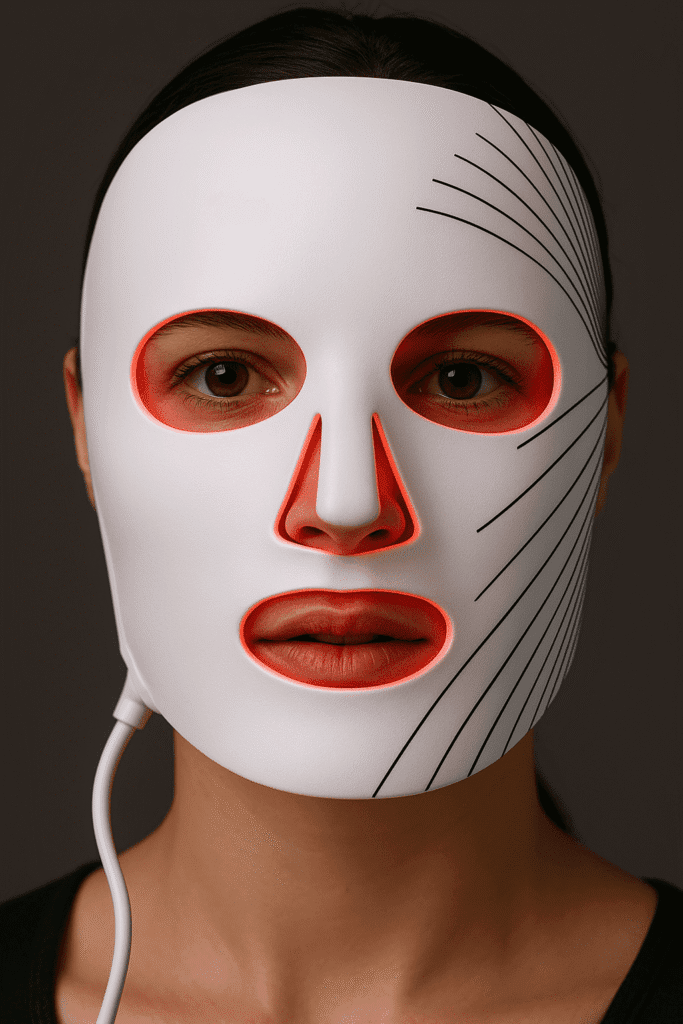
- At-Home RLT: Given rosacea’s chronic nature, home devices are very practical. You can treat yourself several times a week or even daily without incremental cost or scheduling concerns. At-home LED masks (that cover the face) or panels are popular for facial skin issues. For rosacea, a red or red/amber light LED mask can be particularly useful. Amber light (around 590 nm) is another wavelength sometimes marketed for sensitive skin and redness; some at-home masks include amber along with red. These wavelengths are gentle and target superficial skin layers and blood vessels. Many users of at-home RLT for rosacea do a session once a day, often in the evening, which can also be soothing before bed as it doesn’t rev the skin up like some treatments do. The key is consistency: you may need 4-8 weeks of regular use to see pronounced changes, though some report improvements in redness in as little as 2 weeks.
When using at-home devices, technique and patience are important:
- Always start with clean, makeup-free skin. Light should directly reach the skin unobstructed.
- If using a panel, position it at the recommended distance (often a few inches away). If using a mask, just wear it as directed (usually 10-20 minutes per session).
- Many at-home devices are FDA-cleared for improving skin appearance, which covers things like wrinkles and redness. Even though rosacea isn’t named specifically in most device brochures, the underlying action (reducing redness, improving texture) applies.
- Don’t expect the at-home device to do what a vascular laser does; if you have thick red blood vessels, those likely need laser or electrocautery. But for the diffuse redness (background blush) and general sensitivity, at-home red light can make a noticeable difference. Some users even report they can reduce their use of green-tinted makeup primers (which they used to hide redness) because their baseline skin tone becomes less ruddy after consistent RLT.
One caution: Rosacea skin can sometimes be photosensitive. That usually refers to UV, but it’s wise to monitor how your skin reacts to the light. Start maybe with shorter sessions (5-10 minutes) and not on the highest intensity if your device has settings. If you have subtype 1 rosacea (mainly flushing and visible vessels), you’re the ideal candidate for RLT. If you have subtype 2 (with pustules and papules), you might consider blue+red combination devices since blue light could help with the acneiform bumps in tandem with red’s anti-inflammatory effect. Many combo acne devices inadvertently help rosacea because papulopustular rosacea can resemble acne – just be careful if the device is strong in blue light because blue can be a little irritating on very sensitive skin; thankfully, most home devices use low-intensity blue that shouldn’t harm.
How to Choose a Red Light Therapy Device for Rosacea
When selecting a device to help manage rosacea, consider these factors:
- Wavelength and Light Color: For rosacea, red (around 630 nm) and near-infrared (around 850 nm) are primary choices. Some devices also offer amber (around 590 nm) or even green light (around 530 nm) claiming benefits for redness. Red light has the deepest penetration of visible light and directly tackles inflammation. Amber/yellow light penetrates less deeply but is often marketed for calming sensitive skin (though less research exists on amber compared to red). If a device has a combination (e.g., red + amber + infrared), that might provide a comprehensive approach: amber for surface capillaries, red for mid-dermis inflammation, and NIR for deeper support (and possibly impacting related issues like ocular rosacea indirectly by improving circulation – speculative but plausible). Key point: ensure red light is definitely included; pure amber devices might not be as effective alone.
- Device Type: Most rosacea patients will be treating the face, so devices suited for facial use are preferred:
- LED Face Masks: These are shaped to fit the face and target all typical rosacea zones (cheeks, forehead, chin, nose) at once. Look for one that has mostly red LEDs (and ideally covers the cheeks well, since that’s a hot spot for rosacea). A mask that also has near-infrared could be a bonus. Make sure the eye area is protected or keep eyes closed; masks often have goggles or built-in shields.
- Panels: A small-to-medium LED panel that you can position in front of your face is another good option. Panels are versatile (you can use them on other body areas or for general health too). If going this route, consider how you’ll use it: e.g., lying down with panel above you, or sitting with it on a table. It should be large enough to cover your face fairly uniformly or you may treat half the face then the other half.
- Handheld Devices: These can be used if you have very specific problem areas (like just nose and cheeks). They require manually moving them around to cover everything, which can be a bit inconvenient daily. However, if budget is a concern, a handheld is cheaper and you can treat one area at a time (e.g., 3 minutes on left cheek, then right cheek, etc.). Some handheld “wands” also use microcurrents or warmth in addition to red light – those extras aren’t necessary for rosacea and sometimes heat can be a trigger, so plain light-only devices might be preferable.
- Intensity and Treatment Time: Rosacea skin might not need extremely high-powered devices – in fact, too high intensity could provoke a little irritation. Many consumer devices are designed to balance effectiveness with gentleness. If a mask says “10-minute auto session once a day,” that’s usually a sign it provides a proper dose in that time. Some lower intensity devices might require 20-30 minutes. Consider how much time you realistically will commit; a short daily ritual is easier to maintain than a long one. Look at device specs for irradiance (if provided); something in the range of 20-60 mW/cm² at the skin is common for home masks. That’s sufficient for a beneficial effect without being too much.
- Safety and Comfort: For rosacea, comfort is key because any irritation can worsen the condition. Choose a device that is comfortable to wear or use. If a face mask, ensure it has padding or a shape that won’t press excessively on any one area (pressure on skin can sometimes trigger rosacea in that area due to localized stress). Also, devices that get hot should be avoided – the treatment should be cool or just mildly warm at most. Many LED masks are made of rigid plastic; a newer trend is flexible silicone masks which are lighter and more comfortable. Either can work – just weigh comfort vs. durability (rigid ones hold shape, flexible ones conform better).
- User Feedback for Rosacea: Since you are specifically targeting rosacea, it’s helpful to search for reviews or testimonials where people mention rosacea. Some manufacturers might even advertise their device’s benefit for rosacea. For instance, if a product has been featured in an article or blog about “rosacea LED therapy,” that’s a hint it’s a popular choice among that community. A device with red+near-infrared that was mainly made for anti-aging often ends up being great for rosacea because anti-aging treatments revolve around collagen-building and reducing redness too. So don’t shy away from those – just because it’s not labeled “rosacea” doesn’t mean it won’t help.
- Price and Quality: There’s a wide range from inexpensive LED gadgets ($50-100) to more costly masks or panels ($300-$1000). You don’t necessarily need to break the bank; some mid-priced FDA-cleared masks (in the $150-$300 range) have quite good evidence for improving skin redness and quality. Ensure the brand is reputable (FDA clearance is a plus, as it means they presented evidence that the device can improve some skin conditions safely). If you invest in a higher-end panel (like those used by biohackers for various health benefits), you’ll get versatility and probably stronger power – which you can then use at a bit of a distance or shorter time for rosacea. The key is to find something that you will use consistently. A fancy panel that sits in the closet is worthless; a simple mask that you use daily is invaluable.
Tips for Effective Rosacea Management with Red Light Therapy
Implementing RLT into your rosacea care regimen can yield the best results with these tips:
- Gentle Skincare Before and After: Always cleanse your face with a very gentle, rosacea-friendly cleanser before RLT. Pat dry. Do not apply irritating products (like glycolic acid or retinoids, if you even use those for rosacea) right before RLT – it’s better to have bare skin or just a basic hydrating toner. After your session, apply a soothing serum or moisturizer. Some rosacea sufferers use products with niacinamide or ceramides to help barrier; applying these after light therapy can be synergistic since the skin might absorb and utilize them better post-irradiation.
- Avoid Heat Triggers Around Sessions: Try not to do your red light session in a hot environment or right after a hot shower, exercise, etc. You want your skin in a cool, calm state to begin with. Doing RLT in a cool room is ideal. Also, while RLT itself shouldn’t heat you up much, if you use a panel that emits some warmth, maybe have a fan on low or ensure ventilation so you don’t get overly warm (remember heat can cause flushing).
- Eye Protection: Rosacea often affects the eyes (ocular rosacea), but shining bright light directly in eyes isn’t advisable. Most red light devices aren’t harmful to eyes per se (and some research uses red light for dry eyes and ocular inflammation), but these are controlled settings. For now, wear goggles or keep eyes closed during facial RLT. The eyelids and eye area can still benefit from diffused light even with eyes closed. If you specifically have ocular rosacea (gritty, inflamed eyes), treat that with your ophthalmologist’s recommendations (like lid hygiene, possibly light therapy targeted for eyelids under medical supervision – there are some IR light treatments for meibomian glands, but that’s different from typical at-home RLT). In short, don’t stare into the LEDs; it’s fine to treat around the eyes for lid skin redness, but protect your vision.
- Combine with Traditional Treatments Wisely: RLT can work alongside your other rosacea treatments. If you use a topical prescription (like metronidazole, azelaic acid, brimonidine gel, or ivermectin cream), apply those at a different time than your RLT session. For instance, do RLT in the evening, but apply your prescription cream in the morning (or vice versa). This ensures the light doesn’t potentially degrade the medication or cause any unexpected reactions. If you take oral rosacea meds (like doxycycline), there’s no conflict with RLT – in fact, low-dose doxy (a common rosacea anti-inflammatory dose) and RLT might have a complementary effect in tamping down inflammation.
- Lifestyle and Trigger Management: Continue all the good lifestyle habits – red light isn’t a free pass to drink 3 glasses of wine or sit in a hot tub (both known triggers for many). Think of RLT as enhancing your skin’s baseline tolerance. Over time, you may find you’re less reactive to minor triggers, but it’s still wise to avoid the big ones (intense sun exposure without protection, very spicy foods if those bother you, extreme temperature changes, etc.). Using RLT regularly might raise the threshold at which your skin flushes, but it probably won’t erase your innate trigger sensitivity completely.
- Monitor and Adjust: Keep track of your rosacea symptoms when starting RLT. Perhaps take a close-up photo of your face in neutral lighting before you begin, then again after a month of use. Look for changes: are your flushing episodes shorter or less intense? Is the base redness on your cheeks lighter? Are you getting fewer pustules? Often, improvements can be subtle day to day but obvious in side-by-side comparisons. If you notice no improvement after, say, 8 weeks of diligent use, you might re-evaluate the device choice or how you’re using it. Maybe you need a slightly longer session or a different wavelength combination. Or it could mean your rosacea is more severe and needs medical therapy in conjunction. On the other hand, if you see improvement, you might consider scaling back frequency a bit to find a maintenance dose (like after clearing to a satisfactory state, using it 2-3 times a week instead of daily to maintain results, as some do).
Red Light Therapy For Rosacea FAQ
Conclusion
Rosacea can significantly impact one’s self-confidence and comfort, making the search for soothing solutions a priority for millions affected. Red light therapy emerges as a compelling option – a technology-driven yet gentle method to tame the flames of rosacea. By embracing photobiomodulation, individuals are finding they can reduce the persistent redness, quell the bumpy breakouts, and strengthen their delicate skin, all in the comfort of their own home. The charm of RLT lies in its simplicity and safety: a few minutes under the soft red glow, and your skin’s healing responses are activated without a sting, without a pill, without downtime.
From what we’ve gathered, the intersection of scientific research and real-world usage tilts favorably for red light therapy as part of rosacea care. Dermatologists acknowledge its benefits in reducing inflammation, patients report calmer complexions and fewer flares, and even case studies demonstrate measurable improvements. It’s a rare win-win where a treatment is both effective and pleasant – often described as relaxing or therapeutic in its own right.
So, who stands to gain from trying red light therapy for rosacea? In truth, almost anyone with rosacea could potentially see some benefit. It’s particularly suited for:
- Those with persistent facial redness and flushing who want to lessen their dependence on cover-up makeup or just not look “sunburned” all the time.
- Individuals with sensitive skin that reacts poorly to traditional topical meds – RLT gives a non-topical alternative.
- People seeking a maintenance therapy to prolong the remission periods of their rosacea (for instance, between laser treatments or after finishing an oral medication course).
- Biohacking enthusiasts or skincare aficionados who love adopting cutting-edge home treatments – RLT fits neatly into a modern self-care routine.
In closing, as a completely informational and journalist-friendly takeaway: Red light therapy offers rosacea sufferers a ray of hope, literally delivered by light. It leverages a science-backed principle (light-induced healing) to provide real-world relief for redness and inflammation. Importantly, it does so in a way that empowers the patient – giving them a degree of control over their condition through a safe home intervention. While not a standalone cure, it fills an important niche: caring for rosacea-prone skin on a daily basis, making it stronger and less reactive over time. That, in itself, is a significant quality-of-life booster.
If you’re considering illuminating your rosacea away, let this guide serve as a beacon. With the right device, a dedicated routine, and tempered expectations, red light therapy just might turn down the dial on the redness and rekindle your confidence to face the world with a more even, calmer complexion.
🔗 Resources & References
Clinical Research & Scientific Studies
- American Academy of Dermatology – Rosacea Overview
- Sorbellini E, et al. Photobiomodulation with Blue and Red LED Therapy in Rosacea: A Case Report. J Cosmet Dermatol. 2020. DOI link
- Goldberg DJ, Russell BA. Combination Blue and Red Light LED Phototherapy in the Treatment of Acne Vulgaris. J Clin Aesthet Dermatol. 2006;5(2):32–34.
- Avci P, et al. Low-Level Laser (Light) Therapy (LLLT) for Treatment of Hair Loss. Lasers Surg Med. 2014 Feb;46(2):144-51. PMID: 23970445
Dermatologist Commentary & Expert Views
- Cleveland Clinic – Red Light Therapy: Benefits, Side Effects & Uses
- Dr. Dustin Portela, Dermatologist – YouTube: Is Red Light Therapy Legit?
- Fricke A. Can Red Light Therapy Help Rosacea? Interview via MindBodyGreen
Product and Safety Guidelines
- FDA Medical Device Database – Cleared Red Light Devices
- National Rosacea Society – Treatment Options
Patient Communities & Further Reading
- Rosacea Support Group Forum
- Healthline: What to Know About Red Light Therapy for Rosacea
- DermNet NZ – Light Therapy
